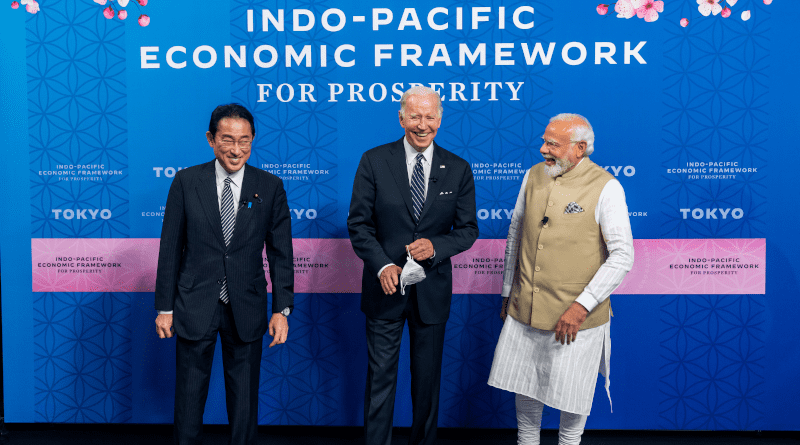What The Indo-Pacific Economic Framework Is And Isn’t – Analysis
By IPCS
By Riya Shah*
In May 2022, US President Joe Biden unveiled the much-awaited Indo-Pacific Economic Framework for Prosperity (IPEF). Launched on the sidelines of the Quad Summit in Tokyo, Biden was joined in-person by Indian Prime Minister Narendra Modi and Japanese Prime Minister Fumio Kishida, and virtually by the leaders of eleven South and Southeast Asian partner countries.
As initial partner countries, the US rallied in support of Australia, Brunei, Fiji, India, Indonesia, Japan, the Republic of Korea, Malaysia, New Zealand, Philippines, Singapore, Thailand, and Vietnam. This US-led economic grouping aims to prepare these economies for the future. It broadly rests on four pillars: trade, supply chain resilience, clean energy and decarbonisation, and taxes and anti-corruption measures. As stated in the joint statement, the framework is “intended to advance resilience, sustainability, inclusiveness, economic growth, fairness, and competitiveness” in the region.
Hailed as the lynchpin of Biden’s economic and trade strategy towards the region, the framework aims to create a free, open, and thriving Indo-Pacific with the tacit intention of containing China. Though in its nascent stage, this Quad-plus initiative’s strategic and political purpose is quite clear. It is ultimately a geostrategic platform that attempts to fill the gap created by the US exit from the Trans-Pacific Partnership (TPP) and bolster regional cooperation to counter China in the region.
Strategic Rationale
The IPEF seeks to provide an alternative to the Regional Comprehensive Economic Partnership (RCEP) and Belt and Road Initiative (BRI) against the backdrop of China’s military and economic manoeuvrings in the region. Indo-Pacific economies have all been grappling with the BRI’s confidentiality clauses, opaque investment practices, and predatory debt traps. IPEF distinguishes itself from BRI by stressing transparency commitments, and purportedly aligns with the Biden administration’s broader trade policy of inclusiveness and fair trade.
The Indo-Pacific constitutes more than 60 per cent of the world’s population and almost 40 per cent of global merchandise trade. The lack of a US presence in the region due to withdrawals from major regional trade agreements has enabled China to emerge as a standard-settingcountry. With regional economic integration through the RCEP, BRI, Comprehensive and Progressive Agreement for Trans-Pacific Partnership (CPTPP), and Digital Economy Partnership Agreement (DEPA), China is already the top trading partner for most IPEF countries. IPEF thus attempts to reassert US economic heft and reclaim its role in Indo-Pacific decision-making processes.
Taiwan was excluded from the framework despite the insistence of a group of 52 US senators, signalling US reluctance to politicise the IPEF and appeasing ASEAN countries that have strong economic ties with China. Nevertheless, it doesn’t include China, the region’s biggest player. Beijing, in turn, has called the IPEF a reiteration of the “China Threat Theory,” a rollback to Cold War mentality and an “economic NATO.”
Political Rationale
The Biden administration plans to roll-out the framework not as a single undertaking but as a platform where countries can join different pillars on an à la carte basis. This approach has two aims.
One, for the US to push through a non-trade agreement into Asia. Since the IPEF is not a traditional regional trade agreement, there is no need for Congressional approval. As previous experiences show, there has been little domestic support for anything that involves lowering tariffs and opening US markets. The proposed trade agreements with Kenya, the UK, and the Environmental Goods Agreement (EGA) have all been scaled back or stalled. Through the IPEF, the Biden administration gets to establish a regional presence while pursuing a foreign policy that focuses on worker-centric trade policies.
Two, the à la carte system tries to make-up for market access and tariff liberalisation shortcomings by providing a flexible framework. Developing economies in South and Southeast Asia might seek cooperation in the lucrative areas of digital trade, but they may not be as keen to equally prioritise the high-standard provisions of decarbonisation and clean energy. So, through its ‘soft-law’ framework, the IPEF serves as a middle ground for Biden to ensure an Indo-Pacific presence. It simultaneously helps him avoid a messy political battle back home, with midterm elections around the corner in November.
Pitfalls and Opportunities
The IPEF will have varying degrees of appeal for member countries. Some common reservations are about the lack of detailed objectives and clear policy actions, a complex negotiation process, an absence of tariff reduction, and the likelihood of the initiative surviving US election cycles. Previous initiatives spearheaded by the US—like the Blue Dot Network, Build Back Better World, and First Movers Coalition—have made little progress, and as a result, a lingering trust deficit overshadows the latest initiative. The IPEF will appeal to the larger Indo-Pacific only if its structural flaws are addressed and it can actually deliver tangible economic benefits instead of solely advancing US security interests.
*Riya Shah is a Research Intern with IPCS’ China Research Programme (CRP).

